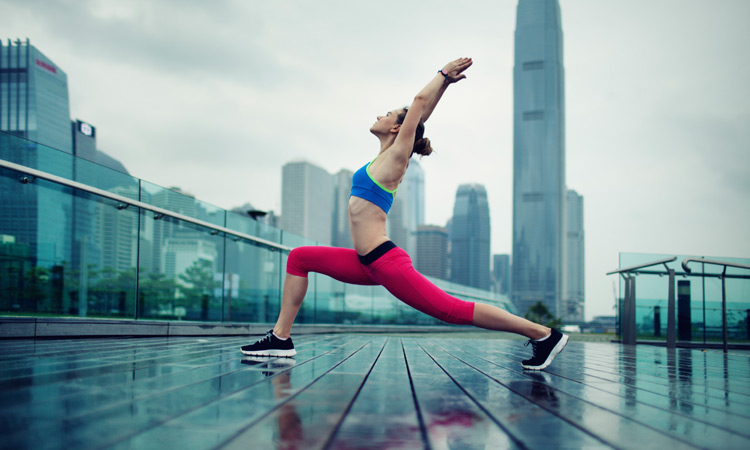 As a writer, I spend hours at a computer, leaning forward over a keyboard. And, as a yoga instructor, I’m hyper-aware of the physical stress that this causes, especially on the shoulders and neck.
As a writer, I spend hours at a computer, leaning forward over a keyboard. And, as a yoga instructor, I’m hyper-aware of the physical stress that this causes, especially on the shoulders and neck.
Modern living in a world of constant stimulation takes a toll, both on the body and within the mind. Long hours spent sitting leads to lower back issues; craning over digital devices results in neck pain. And, once these physical effects begin to manifest, quieting the mind seems to be an impossible feat.
Avoiding these elements of daily life is not an option. Instead, I sought advice from two experts on techniques to calm and control physical issues while creating peace of mind and clarity. These exercises can be done by anyone, anywhere, and at anytime to get back to the way nature intended: healthy and pain-free in both body and mind.
Take a break
Office workers or anyone sitting for periods of time should get up for five minutes at the end of every hour, according to Dr Naresh Rao, a partner with Sports Medicine in New York City and author of forthcoming book Step Up Your Game: The Revolutionary Program Elite Athletes Use to Increase Performance and Achieve Total Health.
To alleviate common work-related complaints regarding the neck, shoulder and lower back, Rao says a few simple techniques will help ease the stress and strain. For example, shoulder rolls and wrist and forearm stretches and rotations. To help screen-staring eyes, Rao suggests every 20 minutes do 10 slow eye blinks. Also, look at a far object for 10 seconds; then, close one eye 10 seconds for 10 times.
Mind the neck
According to Gwen Lawrence, a certified yoga instructor who developed a sports specific yoga-training program for professional athletes, neck issues are a common concern for people of all lifestyles.
Muscles of the neck are located from the base of the skull, to the upper back, shoulders and anterior to the collarbone. Daily stress, long hours at the computer, driving without being mindful, poor posture or sleeping positions can cause these muscles to buckle down, seize and tighten up, Lawrence tells me. Additionally, the weight of the head puts the shoulder and neck muscles to work. If the neck is misaligned, it becomes effortful to hold the head and this surrender to gravity can lead to greater neck pain. To avoid causing more harm than good, Lawrence says to “be super diligent” when working with the neck.
Practice makes perfect
Practicing yoga and constant awareness of proper alignment and posture may help eliminate chronic tension. Be sure to practice relaxation and breathing techniques before beginning these yoga postures.
Traditional neck stretches such as depressing shoulders, ears to shoulders, chin to chest, gentle half neck rolls, lifting the chin and opening the chest can also be helpful before the yoga postures.
Lawrence recommends three helpful poses and to start very slowly and gently; do not expect healing in one day. Explore the postures with the assistance of a yoga instructor to ensure proper alignment.
Child’s pose is a great way to begin, suggests Lawrence. The pose stretches and aligns the lower back while increasing circulation to the discs. Its benefits include increasing hip flexibility and reducing stress. Kneel and slowly lower the torso until the abdomen is on top of the thighs and the forehead rests on the floor. Allow the arms to relax at each side with the palms facing upward. Close the eyes and begin to focus on the breath, paying attention to each inhalation and exhalation.
Camel pose, when practiced properly, says Lawrence, will help stretch the anterior spine, open the shoulders, increase breath capacity, improve neck mobility and flexibility, as well as increase strength in important areas around the neck.
Begin the pose with the knees hip width apart; stand up on the knees with the thighs and torso vertically stacked above the knees. Toes can be tucked or untucked. Place the palms of the hands on the lower back, fingers pointing down, as if you are about to slip the hands into the back pockets of a pair of jeans. Pressing the hands into the back to provide lumbar support, inhale, lifting the chest upward and bending back. On the exhale, push the pelvis forward.
Repeat the cycle of breath and movement, increasing the backbend gently with each inhale. Use the right palm to grasp the right heel and the left hand to grasp the left heel.
Fish pose, says Lawrence, helps counteract the effects of poor posture and long hours at computer, at your desk, or bent over your smart phone. The position encourages many of the benefits as camel. The head touching the ground with gentle resistance increases the bone density of the neck. To do, start by sliding a yoga block underneath the spine, directly under the shoulder blades. Bend backward over the block, releasing and relaxing the back of the shoulders, hips and legs. The back of the head rests on the mat; legs are extended straight. Focus on the breath, holding the pose for 5 to 10 minutes.
Practice these poses carefully and you will slowly see improvement and experience less frequent aches or pain.
Click here to find out about Rose’s thoughts on wellbeing and health


